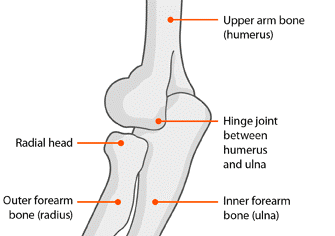Elbow joints can become painful and difficult to move. Often this lack of movement is caused by the joint surfaces not moving smoothly on each other or by tendons and ligaments tightening (contracting) around the joint.
The joint may be too painful to move. Joint replacement can help ease these symptoms.
Do I need an elbow joint replacement?
You may need a joint replacement if:
- your pain can’t be eased enough by other methods, such as drugs, injections or physiotherapy, and is affecting your quality of life
- you can’t use your arm easily
- you have a bone fracture close to the joint that can’t be fixed
Joint replacement surgery should be considered carefully in consultation with your consultant who will be able to advise you on what the surgery involves and on the pros and cons of having or delaying an operation.
What are the possible advantages of elbow joint replacement surgery?
In most cases you can expect that your joint pain will disappear or be much reduced once the wound has healed. Because the joint will be less painful, you’ll probably notice that your range of movement increases. However, this may take several months of hard work and may not happen at all for some people.
Elbow joint replacements are very successful and most people are delighted with the results and the improvement to their quality of life.
What are the possible disadvantages of shoulder or elbow joint replacement surgery?
A replacement joint can never be as good as a natural joint and extreme movements such as hanging washing or reaching for high shelves are often not possible, although most people will be able to carry on with simple everyday activities.
You should discuss with your surgeon before an operation how much they expect your movement to improve, as each case is slightly different.
Replacement joints will also wear out after a time, but it’s likely that they’ll last for 10 years.
What are the alternatives to joint replacement surgery?
Most people with arthritis of the elbow joint will receive other treatments from either their GP, physiotherapist or a rheumatologist before they see a surgeon for a joint replacement. These may include:
- drug treatments, including painkillers and non-steroidal anti-inflammatory drugs (NSAIDs)
- disease-modifying anti-rheumatic drugs (DMARDs) if you have rheumatoid arthritis
- injections of steroid and other drugs into the joint
- injections of local anaesthetic to numb nerves
- physiotherapy
If these treatments don’t improve the pain, you may need surgery.
Elbow replacement
In elbow replacements both sides of the joint are replaced. The upper arm and forearm components (humeral and ulnar components) are made of both metal and plastic. The operation will be carried out using a general and/or a local anaesthetic. The elbow joint is usually opened from the back and the muscles moved back. The parts of the bone with damaged joint surfaces are then removed and the shafts of the prepared ulna and humerus have the components inserted, which are usually cemented in. Most designs have a hinge or pivot between the two halves.

If the arthritis affects only the radial head then a metal radial head replacement is occasionally used. This leaves the rest of your elbow joint unchanged. This may also be used for some fractures.
